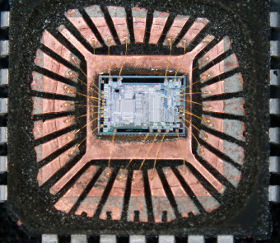NXP MCU P89LPC930 Memory Heximal Cracking
NXP MCU P89LPC930 Memory Heximal Cracking need to solve the automatic addressing mechanism, in the above example SADDR is the same and the SADEN data is used to differentiate between the two slaves. Slave 0 requires a ‘0’ in bit 0 and it ignores bit 1. Slave 1 requires a ‘0’ in bit 1 and bit 0 is ignored. A unique address for Slave 0 would be 1100 0010 since slave 1 requires a ‘0’ in bit 1.
A unique address for slave 1 would be 1100 0001 since a ‘1’ in bit 0 will exclude slave 0. Both slaves can be selected at the same time by an address which has bit 0 = 0 (for slave 0) and bit 1 = 0 (for slave 1). Thus, both could be addressed with 1100 0000.

NXP MCU P89LPC930 Memory Heximal Cracking
In a more complex system the following could be used to select slaves 1 and 2 while excluding slave 0:
In the above example the differentiation among the 3 slaves is in the lower 3 address bits. Slave 0 requires that bit 0 = 0 and it can be uniquely addressed by 1110 0110.
Slave 1 requires that bit1=0 and it can be uniquely addressed by 1110 0101. Slave 2 requires that bit 2 = 0 and its unique address is 1110 0011.
To select Slaves 0 and 1 and exclude Slave 2 use address 1110 0100, since it is necessary to make bit 2 = 1 to exclude slave 2.
The Broadcast Address for each slave is created by taking the logical OR of SADDR and SADEN. Zeros in this result are treated as don’t-cares. In most cases, interpreting the don’t-cares as ones, the broadcast address will be FF hexadecimal. Upon reset SADDR and SADEN are loaded with 0s. This produces a given address of all ‘don’t cares’ as well as a Broadcast address of all ‘don’t cares’ after Crack NXP P87C552 Microcontroller Flash Memory. This effectively disables the Automatic Addressing mode and allows the microcontroller to use standard UART drivers which do not make use of this feature.

